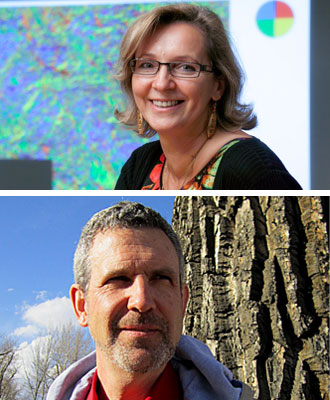Abstract
Assessing the liquid state of bitumen and its production is now possible from 4D seismic. From conventional 4D seismic data, steam chamber volume can be determined. From 3C-4D (3-component, 4-dimensional) PS (P-wave down, converted S-wave up) seismic data, the liquid state of the bitumen, immediately produceable bitumen, and future produceable bitumen can be forecast. This presentation shows how we have done this. During steam assisted gravity drainage (SAGD) processing of an oil sands reservoir, two marked phase changes occur. First, bitumen changes from a quasi-solid state to a produceable liquid state when heated. Changes in the Vp/Vs ratio determined from 3C-4D seismic data in oil sands reservoirs indicate the presence of bitumen heated to its liquid, and therefore mobile and produceable state. Second, a steam chamber develops as the liquid bitumen is displaced with gas and steam during production. Therefore, the size of the steam chamber is used to quantify all these measurements by comparing it to how much bitumen has been produced by the time of the 4D seismic acquisition. From this calibration, and well measurements, it is possible to quantify the other effects. The use of 3C-4D seismic data is critical to assess where the heated bitumen resides in the reservoir because it exists around the steam chamber, and can be detected best by low-frequency changes in the Vp/Vs ratio. The 3C-4D differences allow the visualization of these low-frequency high Vp/Vs ratio zones outside the steam chamber.
The 3C-4D suggest a much broader expanse of mobile oil above and around the steam chamber than might be suggested by Butler (1991) theory. In addition, it appears that a lot of mobile bitumen sits below the producers and therfore will be difficult to produce with a gravity method. This has important implications for the type and placement of infill and extension wells in and around existing SAGD well pairs, as well as for workovers.
Biography
Dragana Todorovic-Marinic
Dragana Todorovic-Marinic, Senior Geophysicist at Nexen ULC, is the author and coauthor of numerous papers, presenter at many industry conferences and she holds both US and CAN patents.
She has been a long time contributor to industry. Dragana’s work spans from the conventional, tight sands, shales, heavy oil to oil sand reservoirs. She has been involved in a broad spectrum of modern seismic advances including work on AVO, azimuthal anisotropy methods, rock properties analysis, seismic inversions, spectral decomposition and more recently 3C-4D seismic monitoring.
With a background in Physics and over 20 years of professional experience including material science research and the petroleum industry, Dragana’s approach to seismic interpretation is simple: Geophysics is just the application of physics to geology. It is not an art, it is a problem solving exercise. The key is to ask the data the right question about the reservoir.
She is the happiest (feels the most accomplished), when her kids think she is funny and the clearest solution to problems come to her while golfing, skiing, hiking or traveling around the world.
David Gray
In 2015 David Gray was honored for his contributions to value in geophysics as the honoree of the 4th annual CSEG Symposium. David has made significant contributions to: quantitative interpretation, where 3 AVO equations have his name on them; seismic fracture characterization, where in 1999 he related azimuthal variations in 3D seismic to fractures in the borehole and where he holds a patent; and in seismic geomechanics where in 2009 he showed that all three principal stresses can be estimated from 3D seismic data and where he also holds a patent.
David joined Nexen in 2010. David joined their Global Exploration and International Development group in 2016 where he is a Senior Geophysical Advisor. David spends the bulk of his time working AVO in Guyana, offshore Canada, and 4D’s from across Nexen’s portfolio. In his previous 6 years at Nexen, David worked in Nexen’s Oil Sands division. Prior to that David did 17 years of research for Veritas and CGGVeritas in reservoir characterization and seismic signal analysis using experience gained as AVO specialist and seismic data processor for Veritas, Geo-X Systems, and Seismic Data Processors, as well as from his internship in the special projects group at Gulf Canada.
David received a Bachelor of Science degree in Honors Geophysics from the University of Western Ontario (1984) and a Masters of Mathematics degree in Statistics from the University of Waterloo (1989). David is a member of SPE, SEG, CSEG, EAGE, and APEGA. He has published and presented about 140 papers within these societies’ journals and conferences and holds three patents. He is a registered Professional Geophysicist in the Province of Alberta.
In his spare time, David likes to spend time with his family, write and present technical papers, work with students and young professionals, and participate in volleyball and grassroots motorsports.






